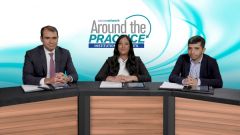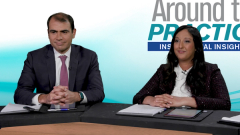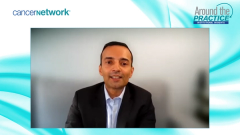
Appropriate Patient Selection for Talquetamab in Relapsed/Refractory MM
Considerations for the integration of GPRC5-targeted therapy into the real-world treatment paradigm of relapsed/refractory multiple myeloma.
Episodes in this series

Transcript:
Ajai Chari, MD, PhD: Al, any thoughts on AE [adverse event] management with dose alterations and dosing schedule?
Alfred L. Garfall, MD, MS: Yes, officially with teclistamab, the FDA approved dose is 15, that 1.5 mg/kg weekly indefinitely. I think there's real opportunity though, just anecdotally, I mentioned the case where our patient was off for several months and didn't have any progression that perhaps we'll learn over time that these drugs can be given more intermittently either with less regular doses or maybe even long treatment holidays that allow you the best of both worlds, the amazing responses and long duration but without accumulative toxicity either with infections and immune increases with BCMA or some of these off target toxicity, the GPRC5D.
Ajai Chari, MD, PhD: And I would just add, for talquetamab AEs in particular, the dosing intensity does seem to play a role. In fact, when we were involved in the very low doses, we didn't see a lot of these non - the non CRS toxicities. It was only with the higher doses. On the one hand, we do see better responses with the higher doses overall and more durability. However, for those patients who respond beautifully, you may not need and keep doing that, right? Skipping a dose, allowing AE recovery, lowering the dose intensity be it the dose or the schedule, goes a long way in preserving the patient's quality of life and yet not sacrificing myeloma control. Because, again, with these immune therapies, I think there's probably wide therapeutic index, right? And we were trying to figure out what that sweet spot is, getting that initial disease control versus long term, right? There's maybe separate doses and that's something that we need to figure out. Krina, did you want to add anything from your perspective about GPRC and its role and sequencing.
Krina K. Patel, MD, MSc: Yes.
Ajai Chari, MD, PhD: Your buddy over there is also dead at CAR-T.
Krina K. Patel, MD, MSc: Exactly. I'm excited about that one. Salivating, right? No, this is phenomenal that we have other targets because I do agree that we can do BCMA sequencing. I'm talking about the future now, right? If we want to cure myeloma, we have all these targets and we have don't have biomarkers right now as you alluded to, right? We don't know which patients have better GPRC5D versus BCMA or maybe a little bit of both on different clones and their immune cells, why did this patient who didn't have a very high dose respond so beautifully versus others at the highest dose that don't respond, right? As we get immune biomarkers, we get more information on antigens, etcetera, combining these, right? So, if there are patients, again, that will - that's a whole another world. But what I'm excited about for all of us to work on in the future is how we're going to be able to attack the different mechanisms. It was actually a different antigen to get more myeloma killed and hopefully one day cured.
Ajai Chari, MD, PhD: And just, Sham, what can you tell us about GPRC CAR-T given that this is such an important target CAR-T? You've done some great work.
Sham Mailankody, MD: Yes, we did the phase 1 study for one of the GPRC5D CAR-T cells, you've probably recently - it's a small study, 17 patients, but heavily pretreated. About half of those patients have had a previous CAR-T cell, this was their second CAR-T cell. About 65% had a previous BCMA directed therapy. And then, in that cohort, we saw about 71% response rate. And in this time, I have a few patients now who are approaching the 2 year mark with ongoing responses for a one and done treatment in patients with previous CAR-T cells, previous allotransplant, etcetera. Certainly, again, another validation of this target GPRC5D as a potential option for our patients. And we, as Krina was alluding to, we are also very interested in combining these targets. So we have a trial now looking at co-administering GPRC5D and BCMA CAR-T cells to patients with very heavily pretreated relapse and refractory myeloma to see if we can get better, more durable responses and more patients by targeting both antigens at the same time.
Transcript edited for clarity.
Newsletter
Stay up to date on recent advances in the multidisciplinary approach to cancer.






















































































